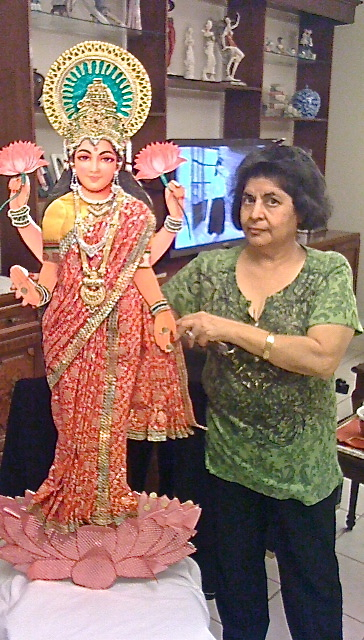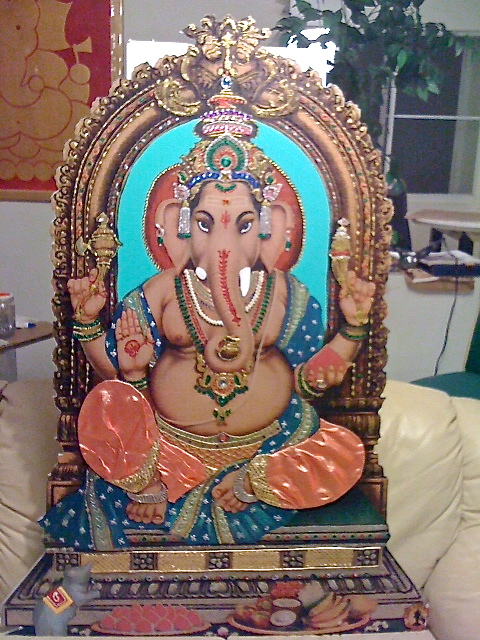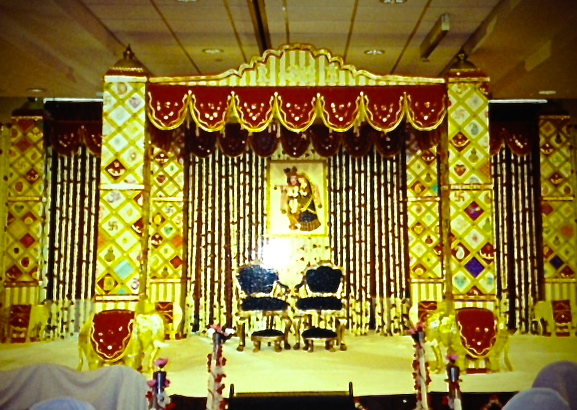
Most of her life she has labored for the family business; today she still takes care of the internal bookkeeping for husband Vashi Dadlani’s shop, Little Europe, in Charlotte Amalie’s tourist district. But she works from their hillside home, where she also maintains a very personal art studio, full of creative works in a mix of genres – paintings, murals, figures, decorative lettering.
“I work mostly in acrylics,” she said, but also in fabric, paint, and myriad other materials. “I do use a lot of gemstones and plaster. I mix the plaster myself.”
Although she is prolific and highly accomplished, her work is little known outside her family and the tight-knit Indian community of St. Thomas.
One reason for her relative obscurity may be that she views her art as a spiritual gift to be shared.
“Anything I do has no monetary value,” she said. While she does donate pieces for sale to raise money for charities, she doesn’t sell items. “I don’t charge for anything.”
Besides, she said, “I’m not really a great artist. It is the blessings of the Lord that guides my hand. You don’t know how many times I get stuck with matching color or the next step, and I take a deep breath and close my eyes and ask for his help and I get the help at the very instant, so it is not my work but his will.”
Her modesty about her work may also have roots in her traditional upbringing.
She was born in the city of Karachi not long before the 1947 partition of India which created Pakistan. Suddenly finding themselves unwelcome in the newly created Muslim country, her Hindu family moved into an area still part of India where she grew up and went to school.
At Alexandria High School, she found a teacher who encouraged her art, but she had to prepare herself for a more practical living. She attended Xavier’s College in Bombay, where she began painting pottery, and did sell works to help pay for her studies. Next there were two years at Nirmala Niketan, a home science college. Here women learned about sewing, nutrition, child rearing, cooking, handicrafts and whatever else they might need to make good wives.

“I didn’t even speak the language,” he said.
But when his family decided it was time for him to marry, they sent him to India to select a bride from among candidates his elders had screened.
“He came in August 1965,” Kavita Dadlani said. “We got married in December 1965. We didn’t know each other.” Then, in an obvious understatement, she added, “It worked out.”
But not without some adjustments.
To begin with, before the ceremony, the bride was Shiela Balani. She lost not only her maiden name to marriage but her first name as well.
As is customary, the priest who performs the ceremony examines both the man and the woman’s horoscopes. If they are completely in harmony, that’s ideal. But often adjustments are needed, and a common one is a name change. The priest determines the first initial that will be most compatible with the man, then instructs the groom to chose a name for his bride beginning with that letter. Only the bride’s family continues to call her by her old name; to everyone else she has become a new woman. And so Shiela became Kavita.
And as soon as she was married, she moved to Haiti, where Vashi’s family had several stores.
“You live with your in-laws,” Kavita Dadlani said. “Even if you get your own place, they control your money, they control the business” and a young woman is subject to her mother-in-law.
Kavita couldn’t travel back to India to see her family unless and until her mother-in-law sent her. That didn’t happen for two and a half years, and then not often after that.
“In those days, you had to do what they say,” she explained. “Indian girls are made to have a lot of patience … We grew up suppressed. It’s not like that now.”
Nor is Kavita, who has earned a reputation as a strong-minded woman.
“Experience makes you more independent,” she said, then added with a smile, “I don’t have a mother-in-law now.”
The Dadlani’s have two grown daughters and three grandchildren. They said one of their daughters had to change her name when she married, the other didn’t. Both now live in the States – far more independently than their parents did.
“If they ask for my opinion, I give it,” Kavita said. “Otherwise, I keep quiet.”
The Dadlani’s moved to St. Thomas in 1976. In recent years, Kavita has devoted more and more of her time to her art.
“A lot of my work is religious,” she said. One recurring motif is Lord Ganesha, the elephant-headed deity sometimes called the remover of obstacles, or the god of success, or of arts and science. “I must have made 100” depictions of Lord Ganesha – each of them a vastly different take on the theme.

She’s lost count of the number of wedding boxes she has made for brides, but said it is more than 20. Bedecked with colorful flowers or romantic scenes, the boxes are meant to hold the more prized possessions a bride brings to her marriage, rather like the old-fashioned “hope chest” of America.
While India is most often the backdrop for her creations, she takes inspiration from her surroundings too. Decorating the bottom portion of a mirrored wall at one end of the Dadlani apartment is a raised, painted mural of colorful fish merrily swimming in clear blue waters.
Almost half way up the wall, one beautiful creature leaps high above the top of the nearest wave. A fish out of water. Soaring.





